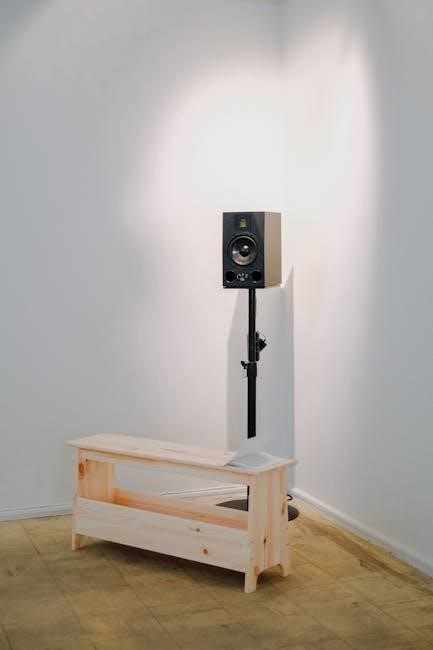A sound wall is a visual tool connecting phonemes (sounds) to graphemes (letters/letter combinations)‚ enhancing phonemic awareness and phonics skills. It organizes sounds‚ with vowels centrally displayed and consonants arranged by articulation‚ providing an interactive learning aid for students to map sounds to spellings effectively.

What is a Sound Wall?
A sound wall is a classroom tool designed to help students connect sounds (phonemes) with their corresponding letters or letter combinations (graphemes). It visually organizes the 44 sounds of the English language‚ making phonemic awareness and phonics instruction more engaging. Unlike word walls‚ which focus on high-frequency words‚ sound walls emphasize the relationship between sounds and spellings. Typically‚ vowels are displayed centrally (often called the “vowel valley”)‚ while consonants are arranged around them‚ grouped by their place and manner of articulation; This structure provides students with a reference point for decoding and spelling‚ fostering a deeper understanding of sound-spelling connections through interactive and visual learning.
Benefits of Using a Sound Wall in the Classroom
Using a sound wall in the classroom offers numerous benefits for students’ literacy development. It enhances phonemic awareness by visually connecting sounds to their spellings‚ making it easier for students to recognize and manipulate sounds in words. The organized structure of a sound wall helps students understand the relationship between sounds and letters‚ improving decoding and spelling skills. It also supports differentiated instruction‚ as teachers can tailor activities to meet individual needs. Additionally‚ sound walls encourage interactive learning‚ allowing students to reference sounds during reading and writing. This tool is particularly effective for visual learners and provides a consistent reference point for practicing sound-spelling connections‚ fostering confidence and independence in literacy tasks.

Sound Wall vs. Word Wall
A sound wall focuses on sound-spelling connections‚ organizing phonemes and graphemes‚ while a word wall displays high-frequency words for sight recognition‚ serving different literacy goals.
Key Differences Between Sound Walls and Word Walls

The primary distinction lies in their purpose and structure. A sound wall is designed to visually organize the 44 phonemes of the English language‚ linking sounds to their corresponding graphemes. It categorizes vowels and consonants‚ often displaying articulation methods‚ to aid phonemic awareness and decoding skills. In contrast‚ a word wall showcases high-frequency sight words‚ focusing on whole-word recognition rather than sound-spelling connections. While both tools support literacy‚ the sound wall emphasizes phonics and spelling patterns‚ making it more aligned with explicit phonics instruction. The word wall‚ however‚ prioritizes instant recognition of common words‚ complementing reading fluency efforts.
Why Sound Walls Are More Effective for Phonemic Awareness
Sound walls are highly effective for phonemic awareness as they provide a clear‚ visual mapping of sounds to their spellings. By organizing phonemes systematically‚ they help students recognize and manipulate individual sounds within words. The structure of a sound wall—with vowels and consonants displayed separately—allows for focused instruction on sound production and articulation. This visual organization enhances students’ ability to identify and differentiate sounds‚ a critical skill for decoding and spelling. Additionally‚ the interactive nature of sound walls enables hands-on learning‚ making phonemic awareness more engaging and accessible for all learners. This targeted approach ensures students develop a strong foundation in sound-spelling connections‚ essential for proficient reading and writing.

Planning and Preparing a Sound Wall
Planning a sound wall involves identifying space‚ materials‚ and organization. Determine how to display sounds‚ introduce new phonemes‚ and establish daily interaction routines for optimal learning.
Identifying Space and Materials Needed
To set up a sound wall‚ identify a prominent‚ easily visible space in the classroom‚ such as a large wall or board. The size will depend on the number of sounds and graphemes to be displayed. Essential materials include sound wall charts or cards‚ markers‚ labels‚ and adhesive hooks or velcro for securing items. Additional materials like grapheme cards‚ vowel and consonant sections‚ and articulation labels can enhance organization. Consider the durability of materials to ensure longevity. Optional items include file folders for individual student sound walls and digital tools for interactive lessons. Plan the layout to ensure clarity and accessibility for all students.
Organizing and Displaying the Sound Wall
A sound wall should be organized to visually represent the 44 phonemes of the English language. Begin by designating a central location for vowels‚ often referred to as the “vowel valley‚” to highlight their importance in syllables. Consonants are arranged around the vowels‚ grouped by their place and manner of articulation (e.g.‚ bilabial‚ alveolar‚ or fricative sounds). Grapheme cards‚ representing the letters or letter combinations that correspond to each sound‚ are added gradually as students learn them. Labels indicating articulation details (e.g.‚ “voiced” or “nasal”) can enhance clarity. This structured display helps students connect sounds to spellings‚ fostering phonemic awareness and phonics skills effectively.
Planning the introduction of new sounds is crucial for effective sound wall implementation. Begin by assessing students’ readiness and aligning new sounds with curriculum goals. Start with high-frequency sounds to build foundational skills. Explicitly teach each sound‚ ensuring students understand its articulation and grapheme correspondence. Introduce one sound at a time‚ using visual and kinesthetic activities to reinforce learning. Gradually release responsibility‚ allowing students to apply their knowledge independently. Schedule regular review sessions to reinforce previously taught sounds‚ ensuring retention and mastery. This structured approach ensures students develop a strong phonemic awareness and can confidently use the sound wall for reading and writing. Consistency and pacing are key to success.

Establishing a Daily Routine for Sound Wall Interaction
Establish a consistent daily routine to maximize the effectiveness of the sound wall. Begin each day with a quick review of previously introduced sounds‚ using the wall to reinforce retention. Model how to use the wall for decoding and spelling‚ demonstrating its practical application. Incorporate guided practice‚ allowing students to interact with the wall independently or in pairs. Encourage students to reference the wall during reading and writing activities‚ fostering self-directed learning. End the day with a brief reflection‚ revisiting any challenging sounds. Consistency ensures the sound wall becomes an integral tool for phonemic awareness and literacy development‚ helping students confidently connect sounds to spellings.
Setting Up a Sound Wall
Organize the sound wall with vowels centrally displayed (vowel valley) and consonants arranged by articulation. Use grapheme cards and labels‚ ensuring accessibility for all students to visually connect sounds to spellings effectively.
Understanding the Structure of a Sound Wall
A sound wall is structured to organize the 44 phonemes of the English language‚ with vowels displayed centrally in a “vowel valley” and consonants arranged by their articulation characteristics‚ such as place and manner of production. This layout helps students visually connect sounds to their spellings. The wall typically includes labels for phonemes and grapheme cards‚ which are added as students learn new sound-spelling relationships. The structure emphasizes phonemic awareness and phonics‚ making it easier for students to identify and manipulate sounds in words. This organized display supports reading and spelling by providing a clear‚ interactive reference for sound-spelling connections.
Creating Vowel and Consonant Sections
The sound wall is divided into two primary sections: vowels and consonants. The vowel section is typically placed in a central location‚ often referred to as the “vowel valley‚” to highlight its importance. Vowels are organized to show their distinct sounds and variations. Consonants are grouped based on their articulation properties‚ such as place (where in the mouth they are produced) and manner (how they are produced). This structure helps students visually connect sounds to their spellings‚ making it easier to identify and manipulate phonemes. The clear separation and organization of vowels and consonants provide a foundational framework for teaching phonemic awareness and phonics skills effectively.
Adding Grapheme Cards and Labels
Grapheme cards and labels are essential components of a sound wall‚ as they visually link sounds to their corresponding spellings. Grapheme cards are added incrementally as students learn new phoneme-grapheme correspondences. Labels‚ including articulation details for consonants and vowel categories‚ enhance understanding. These cards are organized under their respective sounds‚ providing a clear reference for decoding and spelling. The systematic addition ensures students can track their progress and apply their knowledge effectively in reading and writing activities. This structured approach reinforces sound-spelling connections‚ making phonics instruction engaging and accessible for all learners.

Instructional Routines for Sound Wall Use
Instructional routines for sound walls involve daily reviews‚ introducing new sounds‚ and modeling their use in reading and writing. Teachers demonstrate how to decode and spell words using the sound wall‚ fostering phonemic awareness and phonics skills. Interactive activities reinforce sound-spelling connections‚ making literacy instruction engaging and effective for all learners.
Introducing New Sounds to Students
Introducing new sounds to students involves explicit instruction and interactive activities. Teachers start by modeling the sound and its articulation‚ often using visual aids like mouth shapes and grapheme cards. Students participate actively by repeating the sound and identifying words that contain it. The sound wall is used to display new graphemes‚ allowing students to see the connection between sounds and letters. This systematic approach helps students build phonemic awareness and decode unfamiliar words. Daily review of previously introduced sounds ensures retention and reinforces phonics skills. By integrating new sounds into reading and writing exercises‚ teachers create a comprehensive learning experience that promotes literacy growth.
Modeling the Use of the Sound Wall for Reading and Writing
Modeling the use of the sound wall is crucial for students to understand its purpose. Teachers demonstrate how to use the sound wall to decode and encode words by pointing to sounds and graphemes. For reading‚ teachers show how to blend sounds together‚ while for writing‚ they demonstrate how to segment words and match sounds to graphemes. Visual aids‚ such as mouth shapes for articulation‚ help students connect sounds to letters. Hands-on activities‚ like building words with grapheme cards‚ reinforce learning. By modeling these strategies‚ teachers empower students to independently use the sound wall for reading and writing tasks‚ fostering phonics and literacy skills.
Daily Review and Practice with the Sound Wall
Daily review and practice with the sound wall are essential for reinforcing phonemic awareness and phonics skills. Begin each day with a quick review of previously introduced sounds‚ using flashcard drills or word-building activities. Students can practice blending sounds for reading and segmenting words for spelling. Interactive practices‚ such as identifying sounds from words or using pointers to locate graphemes‚ keep the learning engaging. Consistency is key to helping students master sound-spelling connections. Incorporate varied activities to maintain student interest and deepen understanding of phonics concepts.
Interactive Activities to Reinforce Sound-Spelling Connections
Interactive activities are engaging tools to strengthen students’ understanding of sound-spelling relationships. Sound sorting games‚ where students categorize words by sounds‚ and sound scavenger hunts‚ where they find objects matching specific sounds‚ are effective. Word building with magnetic letters or sound wall cards allows students to explore how sounds combine to form words. Additionally‚ activities like “I Spy” using sounds and sound mapping exercises encourage active participation. These hands-on practices help students apply their knowledge of phonemes and graphemes‚ making learning dynamic and enjoyable while reinforcing foundational literacy skills.
Assessment and Support
Sound walls aid in assessing spelling skills and phonemic awareness. They help identify patterns and provide personalized support‚ ensuring students grasp sound-spelling connections effectively and confidently.
Using the Sound Wall for Spelling Tests and Word Analysis
The sound wall is a powerful tool for conducting spelling tests and analyzing words. It allows students to visually connect sounds to their spellings‚ making it easier to identify patterns and relationships. During tests‚ students can refer to the sound wall to decode unfamiliar words or verify spellings. Teachers can use the sound wall to assess phonemic awareness by asking students to identify the sounds they hear in words. Additionally‚ it supports word analysis by helping students break down words into their constituent sounds and corresponding graphemes. This approach reinforces phonics skills and builds confidence in reading and spelling abilities across various learning levels.
Providing Individual Sound Walls for Student Support
Individual sound walls offer personalized learning opportunities for students‚ especially those requiring additional support. These smaller‚ printable versions can be placed in file folders‚ allowing students to reference them independently. This tool is particularly useful for students who need more time to process sounds or those who benefit from repeated practice. Teachers can tailor individual sound walls to focus on specific phonemes or graphemes‚ ensuring targeted support. By having their own sound wall‚ students can practice and review sounds at their own pace‚ reinforcing classroom instruction and building confidence in their phonemic awareness and spelling abilities.
Sound walls are a powerful tool for enhancing phonemic awareness and literacy skills‚ providing students with a clear‚ visual connection between sounds and spellings‚ improving reading and spelling abilities effectively.
The Importance of Sound Walls in Literacy Instruction
Sound walls are a critical tool in literacy instruction‚ serving as a reference point for students to connect sounds (phonemes) with their corresponding letters or letter combinations (graphemes). By organizing the 44 sounds of the English language‚ sound walls help students develop phonemic awareness‚ a foundational skill for reading and spelling. This visual and interactive approach makes abstract sound-spelling relationships concrete‚ aiding students in decoding and encoding words. Sound walls also support differentiated instruction‚ catering to various learning styles and fostering independence in reading and writing. Their effectiveness lies in their ability to create a shared learning environment‚ ensuring all students have consistent exposure to phonics patterns and spelling conventions.
Resources for Further Learning and Implementation
For educators seeking to implement sound walls‚ numerous resources are available to support effective setup and use. Downloadable sound wall PDFs provide starter kits‚ including grapheme cards‚ labels‚ and organizational guides. Manuals like the UFLI Foundations manual offer step-by-step instructions for building and utilizing sound walls. Additionally‚ blogs and educational websites share tips for introducing sounds‚ modeling their use‚ and incorporating sound walls into daily routines. Printable file folder sound walls are also available for individual student use‚ ensuring accessibility for all learners. These resources empower teachers to create engaging‚ learner-centered environments that enhance phonemic awareness and phonics instruction.
